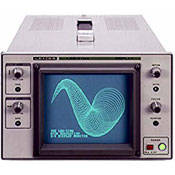Found a second Vectrex. :-)
I have two now, one to play and the second to use for vector rescanning.
This has come all the way from France.
As a retro gaming collector, it hurts to modify this. So I'll try to make as few changes as possible.
Time to open her up.
Be very very careful of the tube. Even after not being powered for weeks they can still retain lethal voltages. So discharge it first.
I used this screwdriver (place under the protective rubber CRT cap) which I attached to ground via the alligator clip. Listen for the pop !
I can't stress enough the risk of discharging the tube. If you are not sure what to do , get a qualified technician. These voltages can kill.
Some pics .. this is the CPU section
In the pic below, the CPU section is on the base, and the XYZ driver board is positioned vertically. It is to the left of the tube.
In the pics below, the XYZ board lies behind the heatsink.
You need to seperate these two boards. and wire the XYZ inputs to the back.
I'll use mini jacks.
Another view of the CPU board. The Red, Blue & Yellow connector is the XYZ connector.
Unplug this.
Rather than cut the female XYZ connector ive decided to use a header to make a new male connector
The pic below is the inside of the case. First, connect all the grounds.
Below is the outside of the case.
The X,Y,Z inputs are controlled with CV
I understand that 0V (on both X and Y) its the centre and that
±9V works on the on the horizontal X input and ±11V on the vertical Y input.
... to be tested.
tHE green wire is ground.
The inside of the jacks
Connect like this to return the Vectrex to normal so you can play games again
I could instead add a switch, though this would involve more holes & drilling.
I've attempted to keep any destruction of this vectrex to a minimum.
So the only permanent modification was drilling the 6 holes for the 3.5mm jacks. All the original wiring is preserved!!! So you can open it up and re-connect the wiring for gaming action!Now that you've modded it what standard eurorack audio modules should you use??
In my test I used:
The elby matrix mixer is a real winner. The bluelantern Thruzero VCO & the steiner microVCO also worked nicely.
Other possible modules:
+ Synovatron CV tools, DPO,
MATHS, Wogglebug."Maths is usually the Z input, I'm mainly just playing with the speed of the pulse - as if it's a really fast envelope.
Then two or more outs from both oscillators in the DPO are going to X & Y,..."+ e340 for X & Y. -- cloud generator+ Thonk/Fonitronik Cascade + If you have a ARP 2600 or a TTSH, the voltage processor is excellent for modifying the 3 input signals + Pip Slope and an O/A/x2 from ALM / Busy Circuits+ PDO and Akemie's Castle + Clouds + 4MS Shifting Inverting Signal Mingler A bit about vector rescanning
My understanding is that the vectrex isn't prefect for vector rescanning as it does not have the bandwidth ....but it kinda works in limited waysIt is better suited for lower frequency oscillographics. However, if you still want to do vector rescanning you need: 1.Video Input to extract luma from your video source2. H & V ramps generator .Thus if you are using Cadet modules you only need one Ramps, a Sync Gen and an Input. A LZX visual cortex (VC) has all of this.Connect the horizontal ramp to the X, the vertical ramp to Y and the luma output (of the VC or the VideoInput) to the Z.
Links
+ Muffs- vector modification+
Vectrex Hackaday+
Hacking a vectrex - Lumpybanger
+
Zektor - using the vectrex monitor
+
Muffs - vector rescanning for dummies +
Muffs - good oscilloscope for vector rescanning---------------------------
Click here to access the Video Index page









































 ..
.. ..
..
 ..
..





 Leader LBO-51MA
Leader LBO-51MA



 ..
..








 ..
..